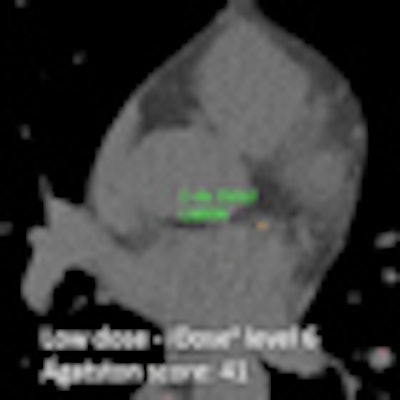
Low-dose coronary artery calcium (CAC) scores are reliable if iterative reconstruction (IR) is applied to the CT data, according to research presented at RSNA 2012. Dutch researchers found that the technology ensures the accuracy of CAC scores that would otherwise be higher and less predictable than the results of higher-dose CT scans.
The study team from Utrecht University compared CAC scores acquired using the Agatston method in standard-dose scans reconstructed with filtered back projection (FBP) to scores from low-dose scans reconstructed using iterative reconstruction (iDose4, Philips Healthcare). They found that the scores acquired using low doses and iterative reconstruction hewed closely to those from the standard-dose scans reconstructed with FBP.
"If we lowered the radiation dose and reconstructed with filtered back projection, a lot of noise was induced, and due to this noise the semiautomatic software package couldn't measure the calcium," said Dr. Martin Willemink in his presentation. "But if we lowered the radiation dose and reconstructed with iDose, the noise was reduced and the semiautomatic software package was able to measure the coronary calcium score."
Recent guidelines recommend that even asymptomatic adults at low to intermediate risk of coronary disease should be evaluated for coronary artery calcium, a recommendation that will result in a growing number of CT procedures. As a result it makes a lot of sense to reduce the radiation dose of these CT procedures as much as possible, he said.
A phantom arm of the study analyzed the effects of low-dose CT (120 kV, 12 mAs) on CAC scores reconstructed with different iterative reconstruction dose levels. The patient study compared the results to CAC scores derived from reference-dose CT scans (120 kV, 40 mAs) reconstructed with FBP.
The iDose4 software was set at different tube current settings, from 10 mAs to 55 mAs, for each of eight cardiac phantoms. In the patient arm of the study, tube current was based on patient size.
The researchers examined 50 consecutive patients (33 men; mean age, 48.9 ± 11.8) who received two CAC scores: the first was obtained with standard-dose CT (80% of the routine dose) and the second was with low-dose CT (20% of the routine dose, or a reduction of 75%), using an electrocardiogram-gated calcium scoring technique on a 256-detector-row scanner (Brilliance iCT, Philips).
The researchers reconstructed the low-dose CT data using both FBP and iDose4 (levels set to 2, 4, and 6), while standard-dose scans were reconstructed using only FBP.
"On all scans, we assessed both the calcium score and the calcium volume," Willemink said.
Heartbeat-CS, a commercially available software application, was used to compare Agatston scores to the calcification volumes, and algorithms were compared using the concordance correlation coefficient and the Wilcoxon signed-rank test.
 |
| CT scans of a patient with an Agatston score of 33 at reference dose (120 kVp, 48 mAs, CT dose index volume [CTDIvol] of 3.8 mGy, effective dose of 0.7 mSv). Lowering the radiation dose (120 kVp, 12 mAs, CTDIvol of 0.9 mGy, effective dose of 0.2 mSv) and reconstructing with FBP resulted in a higher Agatston score of 108. However, lowering the radiation dose and reconstructing with iterative reconstruction resulted in an Agatston score of 41 with iDose level 6, which corresponded closely with the reference dose score. All images courtesy of Dr. Martin Willemink. |
All but seven scans were interpretable, and those seven were all low-dose scans reconstructed with FBP (six with and one without coronary calcifications); they were excluded from analysis in the study. "But all low-dose patients with iDose were successful," Willemink said.
Coronary calcifications were seen in 26 reference-dose scans; in these patients, both Agatston scores and calcification volumes differed significantly between reference dose and low-dose FBP reconstructions (p < 0.001).
Phantom results were accurate from 55 mAs down to about 25 mAs, but scores then rose rapidly without the use of iterative reconstruction, he said.
The mean calcium score on the reference dose in patient studies was approximately 85, he said. Similar to the phantom results, "if we lowered the radiation dose and reconstructed with filtered back projection, the score was significantly decreased; however, if we lowered the radiation dose and reconstructed with iterative reconstruction, scores were approximately similar to the reference-dose scores," Willemink said. "Similarly, if we increase the iDose level, the calcium score decreases, and we can see the same effects in measurements of calcification volumes."
FBP vs. iterative reconstruction
|
|||||||||||||||||||||||
| * p < 0.001 | |||||||||||||||||||||||
The reference radiation dose was approximately 0.7 mSv, and the low dose was approximately 0.2 mSv.
Agatston scores for 26 patients with coronary artery calcification on reference-dose scans differed significantly between reference-dose and low-dose FBP reconstruction (p < 0.001). However, there were no significant differences in the Agatston score between reference-dose FBP and all levels of iterative reconstruction.
Iterative reconstruction led to false-negative Agatston scores of zero in two of the 26 patients at iDose level 6 (reference dose scores: 8.3 and 7.2) and in one patient at iDose level 4 (reference dose score: 8.3).
In 17 patients, reference-dose scans showed no calcifications; however, artifacts produced false-positive calcifications at low-dose CT reconstructed with FBP in 10 of these patients. The use of iterative reconstruction decreased artifacts, resulting in fewer false positives.
Cutting the radiation dose and reconstructing with FBP left seven patients with noninterpretable reconstructions, and 17 patients reclassified at increased risk levels compared to reference-dose exposures, Willemink said. However, if the radiation dose was reduced and reconstructed with iDose, all scans were interpretable and only three to five patients (depending on the iDose level) were reclassified into new risk groups compared to reference-dose results. Still, the low dose is a little too low, Willemink said, because even with the use of iterative reconstruction, approximately16% of patients were reclassified into different risk groups based on low-dose versus standard-dose results.
"Lowering the tube current time product and reconstructing with FBP significantly affected the coronary calcium score; however, lowering the tube current time product and reconstructing with iterative reconstruction resulted in coronary calcium scores corresponding closely with reference-dose coronary calcium scores," Willemink concluded.




















